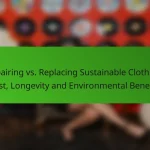What are the consumer preferences in sustainable fashion?
Consumer preferences in sustainable fashion increasingly favor eco-friendly materials, ethical production practices, and transparency in supply chains. These preferences reflect a growing awareness of environmental and social issues associated with the fashion industry.
Preference for eco-friendly materials
Many consumers prioritize clothing made from sustainable materials such as organic cotton, Tencel, and recycled polyester. These materials often have a lower environmental impact compared to conventional fabrics, which can involve harmful chemicals and excessive water usage.
When shopping, look for certifications like Global Organic Textile Standard (GOTS) or OEKO-TEX, which indicate that materials meet specific sustainability criteria. Brands that highlight their use of eco-friendly materials can attract environmentally conscious shoppers.
Interest in ethical production practices
Consumers are increasingly concerned about the labor conditions under which their clothing is produced. Ethical production practices include fair wages, safe working conditions, and respect for workers’ rights. Brands that implement these practices often gain consumer trust and loyalty.
To assess a brand’s ethical stance, check for certifications such as Fair Trade or B Corp. Additionally, many consumers appreciate brands that share stories about their workers and production processes, enhancing their connection to the product.
Demand for transparency in supply chains
Transparency in supply chains is a significant factor for consumers interested in sustainable fashion. Shoppers want to know where their clothing comes from, how it is made, and the environmental impact of its production. This demand for transparency encourages brands to disclose information about their sourcing and manufacturing practices.
Brands that provide clear information about their supply chains can differentiate themselves in a crowded market. Utilizing tools like supply chain mapping and sustainability reports can help brands communicate their commitment to transparency effectively.
How does sustainable fashion impact purchasing decisions?
Sustainable fashion significantly influences purchasing decisions by prioritizing eco-friendly practices and ethical production. Consumers increasingly seek brands that align with their values, often leading to a preference for sustainable options over conventional choices.
Influence of brand values on consumer choices
Brand values play a crucial role in shaping consumer preferences in sustainable fashion. When brands communicate their commitment to sustainability, transparency, and ethical practices, they attract consumers who prioritize these principles. For instance, a brand that openly shares its sourcing practices and labor conditions can build trust and loyalty among environmentally conscious shoppers.
Moreover, consumers are more likely to support brands that engage in social responsibility initiatives, such as fair trade or community development. This alignment of values can lead to stronger emotional connections, making consumers feel good about their purchases.
Willingness to pay premium prices
Many consumers are willing to pay higher prices for sustainable fashion items, recognizing the long-term benefits of ethical production. Research indicates that a significant portion of shoppers may pay 10-30% more for products that are environmentally friendly or socially responsible. This willingness often stems from the belief that sustainable products are of higher quality and contribute positively to the planet.
However, brands must balance pricing strategies carefully. While premium pricing can reflect quality, excessive markups may deter potential buyers. Offering clear value propositions, such as durability or unique design, can justify higher prices and encourage consumer investment in sustainable fashion.
What are the trends in sustainable fashion consumption in the US?
In the US, sustainable fashion consumption is increasingly driven by consumer awareness and demand for eco-friendly practices. Shoppers are prioritizing brands that emphasize sustainability, ethical production, and transparency in their supply chains.
Growth in second-hand clothing market
The second-hand clothing market in the US has seen significant growth, with many consumers opting for pre-owned items as a sustainable alternative to fast fashion. Thrift stores, online resale platforms, and consignment shops are becoming popular destinations for budget-conscious and environmentally aware shoppers.
Platforms like Poshmark, Depop, and ThredUp have made it easier for consumers to buy and sell used clothing, fostering a culture of recycling fashion. This trend not only reduces waste but also allows individuals to find unique pieces at lower prices.
Rise of rental fashion services
Rental fashion services are gaining traction as consumers seek to enjoy high-quality, trendy clothing without the commitment of ownership. These services allow users to rent outfits for special occasions or everyday wear, promoting a more sustainable approach to fashion consumption.
Companies like Rent the Runway and GlamCorner offer flexible rental options, enabling customers to refresh their wardrobes without contributing to overproduction. This model encourages a shift away from traditional purchasing habits, making it easier for consumers to align their fashion choices with their values.
What challenges do consumers face in sustainable fashion?
Consumers encounter several challenges in sustainable fashion, primarily related to the availability of options and the costs associated with these products. These obstacles can hinder the adoption of more environmentally friendly clothing choices.
Limited availability of sustainable options
The limited availability of sustainable fashion options can make it difficult for consumers to find products that align with their values. Many mainstream retailers still prioritize fast fashion, which often overshadows eco-friendly alternatives.
In many regions, sustainable brands may not have a strong retail presence, making it necessary for consumers to shop online. This can lead to additional challenges, such as higher shipping costs and longer delivery times.
Higher costs compared to fast fashion
Higher costs are a significant barrier for consumers considering sustainable fashion. Eco-friendly materials and ethical production practices often result in prices that can be substantially higher than those of fast fashion items.
While some consumers are willing to invest in quality over quantity, the price difference can deter budget-conscious shoppers. On average, sustainable clothing may cost 20-50% more than similar fast fashion items, which can be a considerable factor for many buyers.
How do demographics influence sustainable fashion choices?
Demographics play a significant role in shaping sustainable fashion choices, as different age groups prioritize various aspects of sustainability. Factors such as values, income levels, and lifestyle preferences influence how consumers engage with eco-friendly brands and products.
Millennials prioritizing sustainability
Millennials often prioritize sustainability in their fashion choices, valuing eco-friendly materials and ethical production practices. Many are willing to pay a premium for brands that demonstrate a commitment to environmental responsibility, often seeking out certifications like Fair Trade or organic labels.
Additionally, this demographic frequently supports second-hand shopping and clothing rental services as a means to reduce waste. By choosing these options, they contribute to a circular economy while expressing their personal style.
Gen Z’s focus on social justice
Gen Z places a strong emphasis on social justice within the realm of sustainable fashion, demanding transparency and ethical labor practices from brands. This generation is more likely to research a company’s labor policies and advocate for fair treatment of workers, often using social media to hold brands accountable.
Moreover, Gen Z consumers are inclined to support brands that align with their values, such as inclusivity and diversity. They often prefer companies that actively promote social causes, making their purchasing decisions based on a brand’s stance on issues like racial equality and environmental justice.
What role do social media and influencers play in sustainable fashion?
Social media and influencers significantly shape consumer perceptions and behaviors regarding sustainable fashion. They amplify messages about eco-friendly practices and brands, making sustainability more accessible and appealing to a broader audience.
Impact of influencer endorsements
Influencer endorsements can greatly enhance the visibility of sustainable fashion brands. When a popular influencer promotes eco-conscious products, it can lead to increased brand awareness and consumer trust, often translating into higher sales.
However, not all endorsements are equally effective. Authenticity matters; consumers are more likely to support influencers who genuinely align with sustainable values rather than those who merely promote products for profit. This can be assessed through the influencer’s previous content and engagement with sustainability topics.
Social media campaigns promoting awareness
Social media campaigns play a crucial role in raising awareness about sustainable fashion practices. Brands often use platforms like Instagram and TikTok to share educational content, showcasing the environmental impact of fast fashion and the benefits of sustainable alternatives.
Effective campaigns often include user-generated content, encouraging followers to share their sustainable fashion choices. This not only fosters community engagement but also amplifies the message, reaching potential consumers who may not have been aware of sustainable options.









